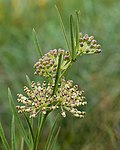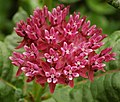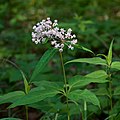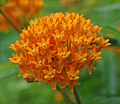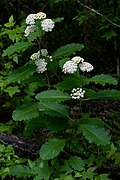Top Qs
Timeline
Chat
Perspective
Asclepias
Genus of flowering plants From Wikipedia, the free encyclopedia
Remove ads
Asclepias is a genus of herbaceous, perennial, flowering plants known as milkweeds, named for their latex, a milky substance containing cardiac glycosides termed cardenolides, exuded where cells are damaged.[4][5][6] Most species are toxic to humans and many other species, primarily due to the presence of cardenolides. However, as with many such plants, some species feed upon milkweed leaves or the nectar from their flowers. A noteworthy feeder on milkweeds is the monarch butterfly, which uses and requires certain milkweeds as host plants for its larvae.
The Asclepias genus contains over 200 species distributed broadly across Africa, North America, and South America.[7] It previously belonged to the family Asclepiadaceae, which is now classified as the subfamily Asclepiadoideae of the dogbane family, Apocynaceae.
Remove ads
Etymology
Summarize
Perspective
In the first century AD, Dioscorides described a plant called ἀσκληπιάς (asklepias) in Greek[8] and Pliny the Elder described a plant called asclepias in Latin.[9] Though usually explained as being derived from the name of the Greek medical god Asklepios, neither author mentioned the god in connection with this plant. Their plant has since been commonly identified as the plant now known as Vincetoxicum hirundinaria.[8] Some botanists have disagreed as, though the old descriptions are short and vague, Vincetoxicum hirundinaria does not have leaves like ivy.[10][11]
Linnaeus first described the genus Asclepias in his Genera Plantarum of 1737 without specifying any particular plants in the genus.[12] Linnaeus published his Flora Suecica in 1745[13] and Materia Medica in 1749.[14] The only Asclepias he mentioned in either book was the one he would later name as Asclepias vincetoxicum. Both books mentioned that in pharmacy this plant was called Hirundinariæ. In none of his works does Linnaeus give an origin for the name Asclepias, presumably because it was being used for these plants by some herbalists and botanists for centuries before.[10] These publications were before his 1753 innovation of names that were simply two words - genus and species - rather than a much longer description.[15]
When Linnaeus described the 18 species that he assigned to the genus Asclepias in his Species Plantarum of 1753, he included Asclepias vincetoxicum.[15] That plant is now called Vincetoxicum hirundinaria. Of those 18, 7 have been assigned to other genera in the years since: Xysmalobium undulatum, Calotropis gigantea, Gymnema lactiferum, Vincetoxicum hirundinaria, Vincetoxicum nigrum, Gomphocarpus fruticosus and Cynanchum thesioides. The species that remain in Asclepias from those Linnaeus described are: A. syriaca, A. amoena and A. purpurascens both now regarded as A. purpurascens, A. variegata, A. nivea, A. incarnata, A. curassavica, A. decumbens and A. tuberosa both now regarded as A. tuberosa, A. verticillata and A. rubra.[7]
Remove ads
Flowers
Summarize
Perspective




Members of the genus produce some of the most complex flowers in the plant kingdom, comparable to orchids in complexity. Five petals reflex backwards revealing a gynostegium surrounded by a five-membrane corona. The corona is composed of a five-paired hood-and-horn structure with the hood acting as a sheath for the inner horn. Glands holding pollinia are found between the hoods. The size, shape and color of the horns and hoods are often important identifying characteristics for species in the genus Asclepias.[16]
Pollination in this genus is accomplished in an unusual manner. Pollen is grouped into complex structures called pollinia (or "pollen sacs"), rather than being individual grains or tetrads, as is typical for most plants. The feet or mouthparts of flower-visiting insects, such as bees, wasps, and butterflies, slip into one of the five slits in each flower formed by adjacent anthers. The bases of the pollinia then mechanically attach to the insect, so that a pair of pollen sacs can be pulled free when the pollinator flies off, assuming the insect is large enough to produce the necessary pulling force (if not, the insect may become trapped and die).[17] Pollination is effected by the reverse procedure, in which one of the pollinia becomes trapped within the anther slit. Large-bodied hymenopterans (bees, wasps) are the most common and best pollinators, accounting for over 50% of all Asclepias pollination,[18] whereas monarch butterflies are poor pollinators of milkweed.[5]


Asclepias species produce their seeds in pods termed follicles. The seeds, which are arranged in overlapping rows, bear a cluster of white, silky, filament-like hairs known as the coma[19] (often referred to by other names such as pappus, "floss", "plume", or "silk"). The follicles ripen and split open, and the seeds, each carried by its coma, are blown by the wind. Some, but not all, milkweeds also reproduce by clonal (or vegetative) reproduction.
Remove ads
Selected species
Summarize
Perspective
There are also 12 species of Asclepias in South America, among them: A. barjoniifolia, A. boliviensis, A. curassavica, A. mellodora, A. candida, A. flava, and A. pilgeriana.
Remove ads
Ecology
Summarize
Perspective
Milkweeds are an important nectar source for native bees, wasps, and other nectar-seeking insects, though non-native honey bees commonly get trapped in the stigmatic slits and die.[17][21] Milkweeds are also the larval food source for monarch butterflies and their relatives, as well as a variety of other herbivorous insects (including numerous beetles, moths, and true bugs) specialized to feed on the plants despite their chemical defenses.[5]
Milkweeds use three primary defenses to limit damage caused by caterpillars: hairs on the leaves (trichomes), cardenolide toxins, and latex fluids.[22] Data from a DNA study indicate that, generally, more recently evolved milkweed species ("derived" in botany parlance) use these preventive strategies less but grow faster than older species, potentially regrowing faster than caterpillars can consume them.[23][24][25]
Research indicates that the very high cardenolide content of Asclepias linaria reduces the impact of the Ophryocystis elektroscirrha (OE) parasite on the monarch butterfly, Danaus plexippus. The OE parasite causes holes to form in the wings of fully developed monarch butterflies. This causes weakened endurance and an inability to migrate. The parasite only infects monarchs when they are larvae and caterpillars, but the detriment is when they are in their butterfly form.[26] By contrast, some species of Asclepias are extremely poor sources of cardenolides, such as Asclepias fascicularis, Asclepias tuberosa, and Asclepias angustifolia.[citation needed]
Monarch butterfly conservation and milkweeds
The leaves of Asclepias species are a food source for monarch butterfly larvae and some other milkweed butterflies.[5] These plants are often used in butterfly gardening and monarch waystations in an effort to help increase the dwindling monarch population.[27]
However, some milkweed species are not suitable for butterfly gardens and monarch waystations. For example, A. curassavica, or tropical milkweed, is often planted as an ornamental in butterfly gardens outside of its native range of Mexico and Central America. Year-round plantings of this species in the United States are controversial and criticised, as they may lead to new overwintering sites along the U.S. Gulf Coast and the consequent year-round breeding of monarchs.[28] This is thought to adversely affect migration patterns, and to cause a dramatic build-up of the dangerous parasite, Ophryocystis elektroscirrha.[29] New research also has shown that monarch larvae reared on tropical milkweed show reduced migratory development (reproductive diapause), and when migratory adults are exposed to tropical milkweed, it stimulates reproductive tissue growth.[30]
Because of this, it is most often suggested to grow milkweeds that are native to the geographical area they are planted in to prevent negative impacts on monarch butterflies.[31][32]
Monarch caterpillars do not favor butterfly weed (A. tuberosa), perhaps because the leaves of that milkweed species contain very little cardenolide.[33] Some other milkweeds may have similar characteristics.
Remove ads
Uses
Summarize
Perspective
Milkweeds are not grown commercially in large scale, but the plants have had many uses throughout human history.[5] Milkweeds have a long history of medicinal, every day, and military use. The Omaha people from Nebraska, the Menominee from Wisconsin and upper Michigan, the Dakota from Minnesota, and the Ponca people from Nebraska, traditionally used common milkweed (A. syriaca) for medicinal purposes.[citation needed] The bast fibers of some species can be used for rope. The Miwok people of northern California used heart-leaf milkweed (A. cordifolia) for its stems, which they dried and used for cords, strings and ropes.[34]
The fine, silky fluff attached to milkweed seeds, which allows them to be distributed long distances on the wind, is known as floss. Milkweed floss is incredibly difficult to spin due to how short and smooth the filaments are, but blending it with as little as 25% wool or other fiber can produce workable yarn.[35]
A study of the insulative properties of various materials found that milkweed floss was outperformed by other materials in terms of insulation, loft, and lumpiness, but it scored well when mixed with down feathers.[36] The milkweed filaments from the coma (the "floss") are hollow and coated with wax, and have good insulation qualities. During World War II, more than 5,000 t (5,500 short tons) of milkweed floss was collected in the US as a substitute for kapok in life jackets.[37][38] Milkweed is grown commercially as a hypoallergenic filling for pillows[39] and as insulation for winter coats.[40] Using milkweed floss for these purposes could provide a plant-based alternative to down and promote the growth of milkweed in areas where it has declined, though there is some concern that the environmental impacts could be negative if monoculture is used.[41]
A. syriaca grown in the St Lawrence Valley of Quebec is known as soie d'Amérique "Silk of America" using a term "silk"[42] applied by the naturalist Charles Sigisbert Sonnini in 1810, when the plant was used in France to produce a fiber for fabric. Milkweed floss can be used in thermal insulation and acoustic insulation. It is highly buoyant and water-repellent, but absorbs oil readily,[43] so it can be used for oil spill cleanup.[44][45][46]

Milkweed latex contains about two percent latex,[clarification needed] and during World War II both Nazi Germany and the US attempted to use it as a source of natural rubber, although no record of large-scale success has been found.[47]
Many milkweed species also contain cardiac glycoside poisons that inhibit animal cells from maintaining a proper K+, Ca2+ concentration gradient.[6] As a result, many peoples of South America and Africa used arrows poisoned with these glycosides to fight and hunt more effectively. Some milkweeds are toxic enough to cause death when animals consume large quantities of the plant. Some milkweeds also cause mild dermatitis in some who come in contact with them. Nonetheless, some species can be made edible if properly processed.[5]
Remove ads
References
External links
Wikiwand - on
Seamless Wikipedia browsing. On steroids.
Remove ads














